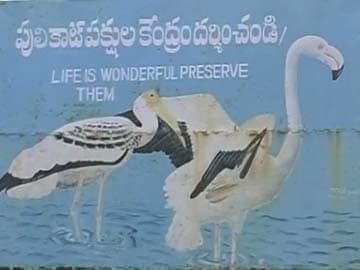
The water lagoon draws more than three lakh birds from around the world.
Chennai:
India's second largest brackish water lake at Pulicat in South India is under threat. If the centre has its way a major 50 million tonne port may come up just two kilometres away.
In January, the UPA government recommended relaxing the mandatory 10 kilometres buffer zone required around important eco-systems to two kilometres. Now environmentalists are up in arms over the proposal. They have even launched an online campaign to save the fragile eco-system.
Spread over Tamil Nadu and Andhra Pradesh, the 600 sq km water lagoon draws more than three lakh birds from around the world. Dredging, environmentalists say would make feeding difficult for them and in turn would lessen the migration of birds in years to come. E Seshan, a wildlife enthusiast told NDTV, "These birds can feed only when the water flow is slow and not so high. When the flow increases they won't get fish, crabs etc."
Fishermen who are dependent on this lake are already worried. After a day's work, Raman's five member team netted just two thousand rupees worth of fish. The port, they say, will further destroy the livelihood of fishermen in 46 villages. He says, "If the port comes up oil would be let out. They won't even let us go near the port. How do we survive and what do we take home?"
According to the proposal, the port and the lake will largely be divided by a 10 km wide Indian Space Research Organisation (ISRO) campus. But at some points the landmass in between is just 200 metres - a big point of concern.
As locals and activists protest, the new Modi government is non-committal. Sources in the environment ministry say they are yet to make the final decision.
The big question is if the centre will toe the previous government's line or have a fresh impact assessment done or shift it to another area within Andhra Pradesh.
In January, the UPA government recommended relaxing the mandatory 10 kilometres buffer zone required around important eco-systems to two kilometres. Now environmentalists are up in arms over the proposal. They have even launched an online campaign to save the fragile eco-system.
Spread over Tamil Nadu and Andhra Pradesh, the 600 sq km water lagoon draws more than three lakh birds from around the world. Dredging, environmentalists say would make feeding difficult for them and in turn would lessen the migration of birds in years to come. E Seshan, a wildlife enthusiast told NDTV, "These birds can feed only when the water flow is slow and not so high. When the flow increases they won't get fish, crabs etc."
Fishermen who are dependent on this lake are already worried. After a day's work, Raman's five member team netted just two thousand rupees worth of fish. The port, they say, will further destroy the livelihood of fishermen in 46 villages. He says, "If the port comes up oil would be let out. They won't even let us go near the port. How do we survive and what do we take home?"
According to the proposal, the port and the lake will largely be divided by a 10 km wide Indian Space Research Organisation (ISRO) campus. But at some points the landmass in between is just 200 metres - a big point of concern.
As locals and activists protest, the new Modi government is non-committal. Sources in the environment ministry say they are yet to make the final decision.
The big question is if the centre will toe the previous government's line or have a fresh impact assessment done or shift it to another area within Andhra Pradesh.
Track Latest News Live on NDTV.com and get news updates from India and around the world

